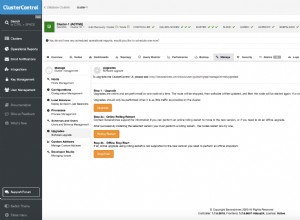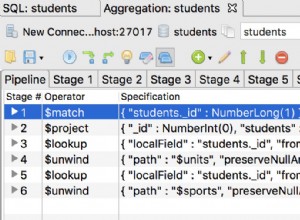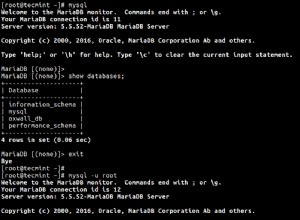Jest to naprawdę proste, aby zsumować wyniki dla każdej tablicy, to tylko kwestia rozróżnienia między tym, które jest które, a „łączenia elementów”. Krótko mówiąc, prawdopodobnie i tak powinieneś to robić w swoich dokumentach, co powinno być oczywiste od pierwszego etapu (etapów) potoku.
Tak więc dla MongoDB 2.6 i nowszych istnieje kilka metod pomocniczych:
db.events.aggregate([
{ "$project": {
"app_id": 1,
"event_count": 1,
"all_events": {
"$setUnion": [
{ "$map": {
"input": "$events",
"as": "el",
"in": {
"type": "$$el.type",
"value": "$$el.value",
"class": { "$literal": "A" }
}
}},
{ "$map": {
"input": "$unique_events",
"as": "el",
"in": {
"type": "$$el.type",
"value": "$$el.value",
"class": { "$literal": "B" }
}
}}
]
}
}},
{ "$unwind": "$all_events" },
{ "$group": {
"_id": {
"app_id": "$app_id",
"class": "$all_events.class",
"type": "$all_events.type"
},
"event_count": { "$sum": "$event_count" },
"value": { "$sum": "$all_events.value" }
}},
{ "$group": {
"_id": "$_id.app_id",
"event_count": { "$sum": "$event_count" },
"events": {
"$push": {
"$cond": [
{ "$eq": [ "$_id.class", "A" ] },
{ "type": "$_id.type", "value": "$value" },
false
]
}
},
"unique_events": {
"$push": {
"$cond": [
{ "$eq": [ "$_id.class", "B" ] },
{ "type": "$_id.type", "value": "$value" },
false
]
}
}
}},
{ "$project": {
"event_count": 1,
"events": { "$setDifference": [ "$events", [false] ] },
"unique_events": {
"$setDifference": [ "$unique_events", [false] ]
}
}}
])
Przeważnie w $setUnion
i $setDifference
operatorów. Drugi przypadek to $map
, który przetwarza tablice w miejscu. Całość polega na wykonywaniu operacji na tablicach bez użycia $unwind
. Ale można to oczywiście zrobić w poprzednich wersjach, wymaga to trochę więcej pracy:
db.events.aggregate([
{ "$unwind": "$events" },
{ "$group": {
"_id": "$_id",
"app_id": { "$first": "$app_id" },
"event_count": { "$first": "$event_count" },
"events": {
"$push": {
"type": "$events.type",
"value": "$events.value",
"class": { "$const": "A" }
}
},
"unique_events": { "$first": "$unique_events" }
}},
{ "$unwind": "$unique_events" },
{ "$group": {
"_id": "$_id",
"app_id": { "$first": "$app_id" },
"event_count": { "$first": "$event_count" },
"events": { "$first": "$events" },
"unique_events": {
"$push": {
"type": "$unique_events.type",
"value": "$unique_events.value",
"class": { "$const": "B" }
}
}
}},
{ "$project": {
"app_id": 1,
"event_count": 1,
"events": 1,
"unique_events": 1,
"type": { "$const": [ "A","B" ] }
}},
{ "$unwind": "$type" },
{ "$unwind": "$events" },
{ "$unwind": "$unique_events" },
{ "$group": {
"_id": "$_id",
"app_id": { "$first": "$app_id" },
"event_count": { "$first": "$event_count" },
"all_events": {
"$addToSet": {
"$cond": [
{ "$eq": [ "$events.class", "$type" ] },
{
"type": "$events.type",
"value": "$events.value",
"class": "$events.class"
},
{
"type": "$unique_events.type",
"value": "$unique_events.value",
"class": "$unique_events.class"
}
]
}
}
}},
{ "$unwind": "$all_events" },
{ "$group": {
"_id": {
"app_id": "$app_id",
"class": "$all_events.class",
"type": "$all_events.type"
},
"event_count": { "$sum": "$event_count" },
"value": { "$sum": "$all_events.value" }
}},
{ "$group": {
"_id": "$_id.app_id",
"event_count": { "$sum": "$event_count" },
"events": {
"$push": {
"$cond": [
{ "$eq": [ "$_id.class", "A" ] },
{ "type": "$_id.type", "value": "$value" },
false
]
}
},
"unique_events": {
"$push": {
"$cond": [
{ "$eq": [ "$_id.class", "B" ] },
{ "type": "$_id.type", "value": "$value" },
false
]
}
}
}},
{ "$unwind": "$events" },
{ "$match": { "events": { "$ne": false } } },
{ "$group": {
"_id": "$_id",
"event_count": { "$first": "$event_count" },
"events": { "$push": "$events" },
"unique_events": { "$first": "$unique_events" }
}},
{ "$unwind": "$unique_events" },
{ "$match": { "unique_events": { "$ne": false } } },
{ "$group": {
"_id": "$_id",
"event_count": { "$first": "$event_count" },
"events": { "$first": "$events" },
"unique_events": { "$push": "$unique_events" }
}}
])
Daje to pożądane wyniki z każdą tablicą "sumowaną" razem, a także główną "event_count" z poprawnym wynikiem.
Prawdopodobnie powinieneś rozważyć połączenie obu tych tablic z identyfikatorem podobnym do tego, który został użyty w potokach, jak pokazano. Ta część to połowa pracy. Druga połowa to rozważenie, że prawdopodobnie powinieneś przechowywać wstępnie zebrane wyniki gdzieś w kolekcji, aby uzyskać najlepszą wydajność aplikacji.




